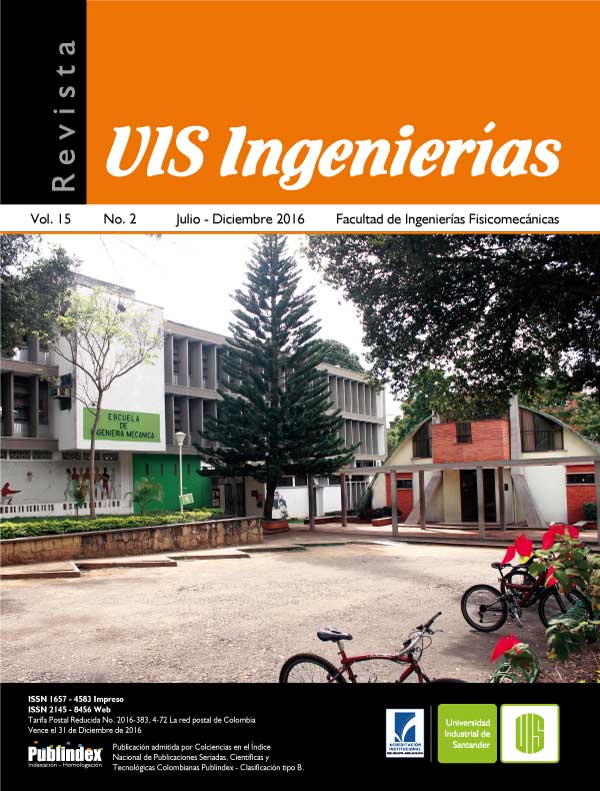Implementación de ROS en sistema de control para un seguidor de personas usando robot Pioneer 3-DX
Publicado 2016-06-08
Palabras clave
- Carmine,
- Pioneer,
- robótica,
- ROS,
- seguidor de personas
- sistemas de control ...Más
Cómo citar
Resumen
Robot Operating System(ROS) proporciona algoritmos y servicios para el control de diferentes tipos de robots. ROS es una herramienta útil en muchos problemas en el campo de los robots autónomos, especialmente en aplicaciones como la cartografía, localización y navegación autónoma en un ambiente interior. La navegación autónoma en un entorno dinámico contempla muchos factores ambientales que afectan el proceso de navegación. El enfoque de este trabajo es desarrollar un sistema modular para llegar a un seguidor humano utilizando un robot PIONEER 3-DX y un sensor Carmine PrimeSense,con el apoyo de hilos por cada pasode procesamiento a través de paquetes desarrollados enROS. Estas etapas se dividen en: búsqueda y ubicacióndel usuario a seguir, estimación de la dinámica del robot, control de velocidades y por último, un módulo de seguridad de evasión de obstáculos.
Descargas
Referencias
[2] Tinós, R.; Terra, M.H. ; Ishihara, J.Y. “Motion And Force Control Of Cooperative Robotic Manipulators With Passive Joints”. IEEE Transactions on Control Systems Technology, (Volume:14 , Issue: 4 ). July 2006.
[3] KWOW, et al. “PSOBased Cooperative Control of Multiple Mobile Robots in Parameter-Tuned Formations”. Proceed. 3rd Ann. IEEE Conf. on Automation Sc. and Eng. Scottsdale, US, pp. 332 – 337, 2007.
[4] Y.Q. CHEN y Z. Wang,“FormationControl: A Review And A New Consideration”. In IEEE/RSJ International Conference on Intelligent Robots and Systems, 3181-3186 pp. 2005.
[5] Diaz del Rio, F. ; Jiménez, G. ; Sevillano, J.L.; Vicente, S. ; Civit Balcells, A. “A Generalization Of Path Following For Mobile Robots”. IEEE International Conference on Robotics and Automation, 1999. Proceedings. 1999 (Volume:1). 1999.
[6] F. Bravo, et al, “Switching control and modeling of mobile robots formation”. Fac. of Eng., Dept. of Electronics, PUJ,. Bogotá, Colombia.
[7] J.M. O´aKane, A Gentle Introduction to ROS. Columbia: Department of Computer Science and Engineering, 2014
[8] MobileRobots. (2014, oct 12). Mobile Robots. [Online] Available: http://www.mobilerobots.com/Software/ARIA.aspx
[9] ROS. (2014, 12 11). ROS. [Online] Available: http://wiki.ros.org/ROSARIA
[10] ROS. (2014, 12 16). ROS - openni_camera. Available: https://goo.gl/q0SDjh
[11] J. Borenstain et al, Human Leader and Robot Follower Team: Correcting Leader´s Position from Follower´s Heading. Orlando, 2010.
[12] PrimeSense, Willow Garage, ASUS, & Open Perception. (2014, 12 16). OpenNI. [Online]. Available: http://openni.ru/index.html
[13] PrimeSense. (2014, 12 16). OpenNI - NITE 2. [Online]. Available: http://www.openni.ru/files/nite/index.html
[14] PrimeSense. (2014, 12 16). i3du. [Online]. Available: https://goo.gl/uNwI6b
[15] Guerin, K. (2014, 12 16). github. [Online]. Available:https://github.com/futureneer/openn i2-tracker/blob/master/src/tracker.cpp
[16] PrimeSense. (2010). Prime Sensor NITE 1.3 Algorithms notes

